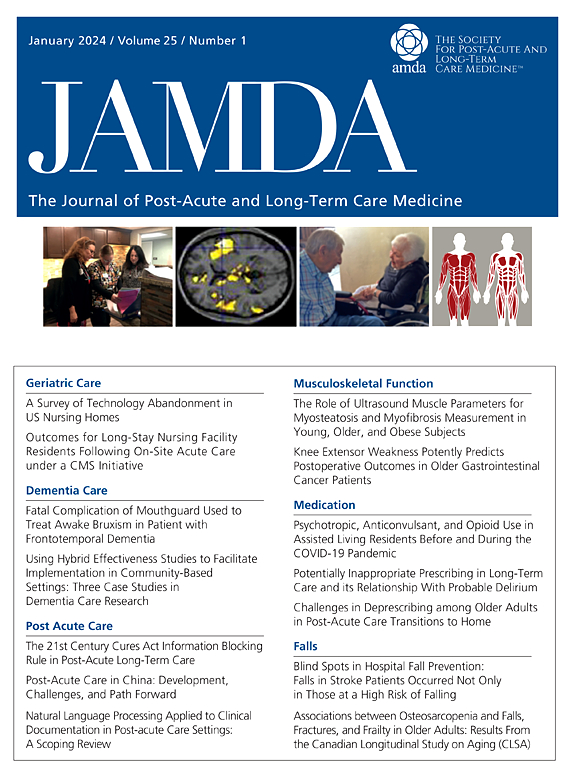双重参加医疗保险和医疗补助的辅助生活居民的住院风险。
IF 4.2
2区 医学
Q2 GERIATRICS & GERONTOLOGY
Journal of the American Medical Directors Association
Pub Date : 2025-02-01
DOI:10.1016/j.jamda.2024.105421
引用次数: 0
摘要
目的:研究在辅助生活(AL)居民中,医疗保险和医疗补助的双重登记以及在辅助生活社区中双重登记的个人百分比是如何不同的住院风险的。设计:回顾性队列研究。背景和参与者:我们使用2008年至2018年的医疗保险数据和全国许可的AL社区目录来确定医疗保险受益人,他们的邮政编码发生了变化,表明他们在AL社区有了新的住所。方法:我们估计住院的线性回归模型与居民的双重登记状态和双重登记居民的百分比类别之间的相互作用。在模型中,我们调整了个人水平的临床和人口统计学特征、年度固定效应和AL居民先前邮政编码的固定效应。结果:在620,542名搬到AL社区的Medicare受益人中,双入组居民的1年住院风险高于单入组居民。在调整后的模型中,双入组的高双入组社区居民(50%双入组)入院风险比低双入组社区居民高7.4%。高双AL社区的医疗保险受益人住院的风险比低双AL社区的医疗保险受益人高9.4%。结论和意义:AL社区中双入组的居民比例与居民住院风险相关,无论其双入组状态如何。需要进一步的研究来了解观察到的居民住院风险的差异是否由于所提供服务类型的差异、未测量的居民敏锐度或在这些环境中提供的护理质量的差异。本文章由计算机程序翻译,如有差异,请以英文原文为准。
Risk of Hospitalization Among Assisted Living Residents Dually Enrolled in Medicare and Medicaid
Objectives
To examine how risk of hospitalization among assisted living (AL) residents differs by dual enrollment in Medicare and Medicaid and by the percent of dually enrolled individuals in an AL community.
Design
Retrospective cohort study.
Setting and Participants
We used Medicare data from 2008 to 2018 and a national directory of licensed AL communities to identify Medicare beneficiaries with a change in their ZIP+4 code suggesting a new residence in an AL.
Methods
We estimated linear regression models of hospitalization onto interactions of residents' dual enrollment status and categories of the AL community’s percentage of dually enrolled residents. In the models, we adjusted for person-level clinical and demographic characteristics, year-fixed effects, and fixed effects for the AL residents’ prior ZIP code.
Results
Among 620,542 Medicare beneficiaries who moved to an AL community, the 1-year risk of hospitalization was higher for dually enrolled residents compared with Medicare-only residents. In adjusted models, dually enrolled residents in high-dual AL communities (>50% dually enrolled) had an 7.4% higher risk of hospital admission compared with dually enrolled residents in low-dual AL communities. Medicare-only beneficiaries in high-dual AL communities had a 9.4% higher risk of hospitalization than Medicare-only beneficiaries in low-dual ALs.
Conclusions and Implications
The proportion of residents in an AL community who were dually enrolled was associated with residents' risk of hospitalization, regardless of their dual enrollment status. Additional research is needed to understand whether differences observed in residents’ risk of hospitalization are due to differences in the types of services provided, unmeasured resident acuity, or the quality of care delivered in these settings.
求助全文
通过发布文献求助,成功后即可免费获取论文全文。
去求助
来源期刊
CiteScore
11.10
自引率
6.60%
发文量
472
审稿时长
44 days
期刊介绍:
JAMDA, the official journal of AMDA - The Society for Post-Acute and Long-Term Care Medicine, is a leading peer-reviewed publication that offers practical information and research geared towards healthcare professionals in the post-acute and long-term care fields. It is also a valuable resource for policy-makers, organizational leaders, educators, and advocates.
The journal provides essential information for various healthcare professionals such as medical directors, attending physicians, nurses, consultant pharmacists, geriatric psychiatrists, nurse practitioners, physician assistants, physical and occupational therapists, social workers, and others involved in providing, overseeing, and promoting quality

 求助内容:
求助内容: 应助结果提醒方式:
应助结果提醒方式:


